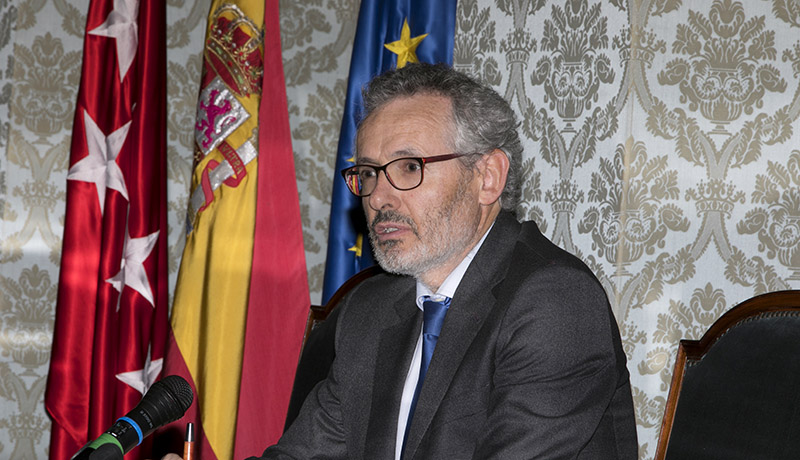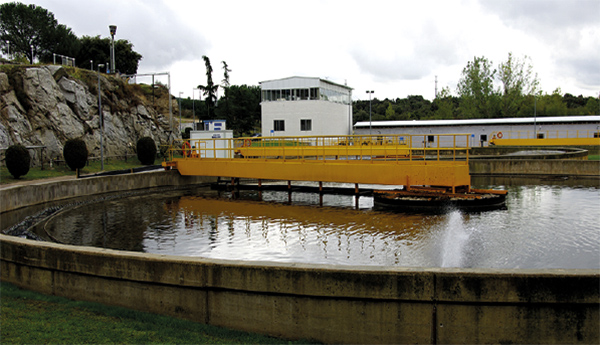“Our water regulatory framework is the most advanced in the world; however, a stricter application is needed.”
Interview to ETSIAAB’s professor Alberto Garrido, Director of The Water Observatory of the Botín Foundation, think tank awarded by the UPM.
February, 2021
Alberto Garrido, professor of the Escuela Técnica Superior de Ingeniería Agronómica, Alimentaria y de Biosistemas (ETSIAAB), is the Director of The Water Observatory of the Botín Foundation. The Universidad Politécnica de Madrid (UPM) awarded this think tank, focused on innovation in water resource management, with the public-private partnership Prize of Cooperation for Sustainable Development Goals. Mr Garrido, who also serves as Vice-Rector for Quality and Efficiency of the UPM, recognises that global warming makes the so valued commodity management rather tricky, noting sewage treatment as one of the main tasks to improve in Spain.
What are the main activities developed by The Water Observatory?
The Water Observatory, created in 2009, is a think tank of excellence that aims to contribute to water improvement in Spain and other countries, transferring new knowledge, serving as a platform for debate and bringing society closer to this improvement. We are aware of the fact that scientific knowledge is not enough to change things. However, we try to influence perceptions of citizens, civil society, companies and administrations, spreading knowledge and creating innovative spaces and experiences to inspire and transmit values in favor of environmental conservation. Besides, the UPM has been part of The Water Observatory since the beginning, and many of our MSc and PhD students have experienced it.
Is water a scarce good as we are used to hearing, or a poorly managed resource? Or both?
Indeed, it is a scarce commodity in Spain and almost every overpopulated part of the world. Even in the wetland areas of Spain, there is competition for water among diverse users. We have checked that, even when demands are satisfied, the river water flow regime set by the Law is rarely respected. I would not say it is poorly managed, because, as I see it, nowadays we work it better than in the past. However, global warming's effects multiply and aggravate the problems, particularly in Spain, due to inadequate and insufficient sewage treatments.

Alberto Garrido.
What is the best water management model for Spain? Is it a proper regulatory framework?
The proper model is the one that works, and we have clear examples of that under the regulatory framework arising from the corresponding Community Directive, known as Water Framework Directive adopted in 2000. Therefore, the regulatory framework is the most advanced in the world; however, a stricter application is needed.
Water, agriculture and the environment. Can the circle be squared?
Since eco-systemic uses, functions, and services rarely can be harmonised, it cannot be done in most cases. It is a case of a permanent state of goal competences. We support step-by-step improvement, making all water functions and uses gradually more compatible, seeking consensus. Of course, we count on some strategies, such as more effective water treatment and reuse, and probably water desalination, that open up new possibilities. We also consider that water is managed in times of plenty and scarcity and its best distribution depends on the specific situation. This flexibility is one of the critical factors and extends opportunities to keep irrigated agricultural production with reasonable prospects of success. We should also mention agricultural engineers' role in choosing the best crop management, irrigation technology, and resource management. Their knowledge has been crucial in ensuring that Spain's agricultural water use has remained constant or slightly downwards, while harvest value has increased.
What mark would you give to the status of the rivers in Spain? Do we need to worry about the hydromorphological alterations and the quality of their water?
Remarkably, there are much worse situations in other EU countries. The high areas of the rivers, the headwaters of most Spanish basins are in good shape. However, the rivers' low and middle reaches do not show a good environmental status due to hydromorphological alterations and quality deterioration. We should take into account that water is a renewable resource that can almost always be improved. Besides, water flow in good status can spread out. For instance, if water sewage plants in Madrid treated more, the water in Aranjuez, Toledo or Talavera de la Reina, and even in Lisbon, would be of better quality.
The Mediterranean region is likely to be badly affected by climate change with a decline of rainfall.
It is not clear that rainfall will decrease, models project contradictory scenarios. There will be less water simply because warming increases evaporation and evapotranspiration of wild vegetation and crop species. Just because of this, less river water will flow, and there will be less groundwater recharge. If extreme events increase in frequency and severity, and there is little discussion, water management in the Mediterranean region will become even more complicated.

Water sewage plant.
Should farmers of some areas consider replace irrigation crops with rainfed crops?
A truism that a farmer can irrigate will always do so: the more controlled crop management conditions are, the more significant is the efficiency of the factors involved, and yielding per inverted euro. Consequently, a shift from irrigation to rainfed crops can only be applied with the application of new legislation. From my previous point, water management must be flexible; it should be adapted to specific conditions; when there is less irrigation water, farmers should irrigate less or sow smaller areas of irrigation crops. On certain occasions, the irrigated area will have to be reduced. Nonetheless, I think all options need to be exhausted and taken to the extreme to promote water management flexibility and water use flexibility to be adapted to specific conditions. Also, more investment is needed into technology, treatment, filtering and desalination on coastal areas.
Water transfers among river basins always cause social and political tensions.
Here and everywhere. It is quite logical that in areas where water is transferred, people ask themselves questions, and politicians use these arguments and grievances. However, you can find water transfers worldwide: California and southwest USA, Australia, Turkey, France, China... There is a controversy right now about a possible transfer from the Ebro swamp in Cantabria to Santander of 5 cubic hectometres/year. But we need to remember that there are 8 water transfers in the Ebro. The one that supplies El Gran Bilbao provides a maximum of 150 cubic hectometres per year; therefore, I find this controversy about the transfer to Santander odd. Undoubtedly the era of large water transfers is a thing of the past almost everywhere, mainly because desalination has become much cheaper.
Is there much room for improvement in infrastructure for water?
A vast room indeed. Again, sewage purification, treatment and reuse. It is said that Spain needs 20,000 million euros in this area. Many small towns do not treat their water, and in large cities, such as Madrid, the level is insufficient.
Besides agriculture, what do urban centres pose water-related challenges? And what about the tourism and industrial sectors?
Water purification, treatment, reclamation and reuse. In particular, management and use of storm-water, paving, double-circuit installations in houses, gardening... there is still a great deal of work to be done.

